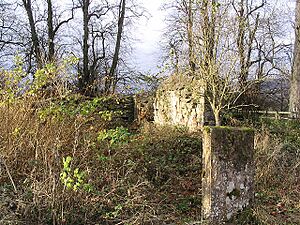David Calderwood facts for kids
Quick facts for kids David Calderwood |
|
|---|---|

The remains of Crailing Old Parish Church
|
|
| Personal details | |
| Born | 1575 probably Dalkeith |
| Died | 29 October 1650, age 57 Jedburgh |
| Denomination | Church of Scotland |
David Calderwood (1575–1650) was an important Scottish minister and historian. He was known for standing up for his beliefs. David Calderwood was sent away from Scotland because he disagreed with the king's church rules. He found a new home in the Netherlands. There, he wrote a famous book called Altare Damascenum. This book argued against having bishops lead the church.
Later, he returned to Scotland. He was part of a big meeting called the Glasgow Assembly in 1638. At this meeting, the Church of Scotland decided to remove bishops and change its worship style. David Calderwood died in Jedburgh. He was buried in the churchyard of Crailing, where he first started his work as a minister.
Contents
Why did David Calderwood clash with the King?
David Calderwood was born in Dalkeith, Midlothian, Scotland. He studied at the college in Edinburgh. In 1604, he became a minister in Crailing, Roxburghshire. This was a time when King James wanted to change the Church of Scotland. The king wanted to bring in prelacy, which meant having bishops lead the church. Calderwood was one of the strongest people who opposed the king's plan.
How did Calderwood protest against the King?
In 1608, a bishop named James Law came to Jedburgh. He tried to choose church leaders who supported the king. Calderwood openly spoke out against the bishop's power. Because of this, he was not allowed to attend church meetings. He was also told to stay only within his own parish. This stopped him from taking part in public church matters.
In 1617, King James visited Scotland. This gave Calderwood another chance to protest. Some ministers met in Edinburgh to discuss church issues. When the king tried to pass a rule giving him power over the church, Calderwood and other ministers signed a protest.
What happened when Calderwood met the King?
The king called Calderwood to explain his "rebellious" actions. A strange conversation happened between them. The king thought he was good at arguing. He tried to debate with Calderwood. Even though Calderwood was on his knees, he answered the king calmly and cleverly. He managed to outsmart the king.
The people around the king were shocked by Calderwood's brave answers. Even some of Calderwood's friends tried to get him to be more polite. Sometimes, the king got angry and called him names. In the end, Calderwood was removed from his church job. He was put in prison and then told to leave the country.
What did Calderwood do in Holland?
Calderwood went to Holland and stayed there until King James died in 1625. While there, he became very sick. A rumor spread that he had died. People even said he had changed his mind about his beliefs.
But Calderwood showed he was alive and well! He published a book called ‘'Altare Damascenum. It was published under a different name, ‘Edwardus Didoclavius’. But everyone knew it was Calderwood's work. This book was very important. It strongly argued against the idea of bishops in the church. Many people read it and became supporters of the Presbyterian church.
When did Calderwood return to Scotland?
After King James died, Calderwood returned to Scotland in 1625. For a while, he did not have a church job. He was a powerful writer who argued well. But he wasn't known for being a great speaker or having a very friendly manner.
It wasn't until 1640 that he became the minister of Pencaitland in East Lothian. He worked with other important ministers to create the Directory for Public Worship. This document set the rules for how church services should be held in the Church of Scotland.
What was Calderwood's most important work?
Calderwood's biggest project was writing his History of the Kirk of Scotland. When he was 73 years old, the church leaders gave him money every year. This helped him finish his important history book.
He wrote his history in three different ways. The first was very long. The second was a shorter version, but it still had all the main information. This version was published in eight books. The third was an even shorter summary.
Calderwood's history book is not easy to read like a story. But it is a very important source of information. It tells us a lot about the church history of Scotland. It covers events from the time of Mr. Patrick Hamilton until the death of King James the Sixth.
Did Calderwood have a family?
It seems David Calderwood never married. He left his papers to his brother's family. One family member later gave the manuscripts of his history book to the British Museum. Other collections of his papers were also saved and are now kept by the Faculty of Advocates.
Images for kids


